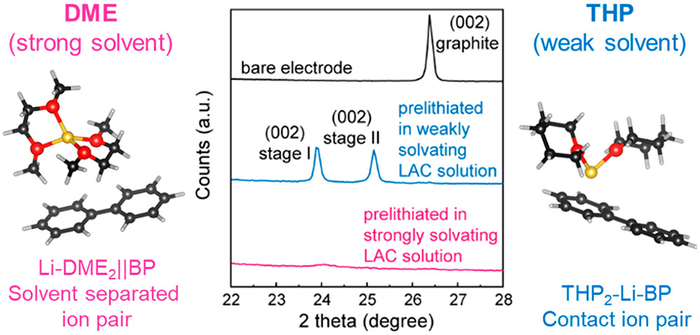Reviewed by Alex SmithAug 25 2021
Researchers from the Korea Institute of Science and Technology (KIST) developed an electrode pre-treatment solution that helps reduce the initial Li-ion loss.
 A chemical prelithiation method to maximize the ICE of the blend anodes using a reductive Li-arene complex solution of regulated solvation power, which enables a full cell to exhibit a near-ideal energy density. Image Credit: Korea Institute of Science and Technology.
A chemical prelithiation method to maximize the ICE of the blend anodes using a reductive Li-arene complex solution of regulated solvation power, which enables a full cell to exhibit a near-ideal energy density. Image Credit: Korea Institute of Science and Technology.
An electronic device, when its batteries are fully charged, will usually signal that it is at 100% capacity. Yet, this value portrays only 70%–90% of the theoretical energy density that can be stored in the batteries. This is due to the permanent loss of Li ions that takes place at the time of the initial charge in the stabilization (formation) stage of the battery development.
If this primary loss of Li ions is avoided, the mileage of electric vehicles (EVs) and usage time of smartphones can be significantly enhanced.
Researchers from KIST, headed by Dr. Minah Lee from the Center for Energy Storage Research, Dr. Jihyun Hong from the Center for Energy Materials Research and Dr. Hyangsoo Jeong from the Center for Hydrogen-Fuel Cell Research, created an electrode pre-treatment solution capable of reducing this initial Li-ion loss in graphite-silicon oxide (SiOx, 0.5 ≤ x ≤ 1.5) composite anodes.
The anode — composed of 50% SiOx — when dipped in the solution, showed negligible Li loss, allowing a full cell to display near-ideal energy density.
When a majority of the commercial Li batteries employ a graphite anode, SiOx gathers attention as the state-of-the-art material for anodes owing to its greater capacity, which is 5–10 times higher than graphite. However, SiOx also irreversibly takes in three times more active Li as graphite.
Therefore, a composite electrode, comprising a mixture of graphite and SiOx, is now attaining recognition as an alternate for practical next-generation anodes. However, when there was a significant increase in the capacity of graphite–SiOx composite electrodes at greater ratios of SiOx, an increase in loss of initial Li was noted.
Therefore, the ratio of SiOx content in a graphite-SiOx composite electrode was restricted to 15%, as increasing the ratio to 50% will result in an initial Li loss of 40%.
To attain high capacity and high initial efficiency simultaneously, researchers put forth different prelithiation techniques involving the pre-doping of extra Li into the anode. Dr. Minah Lee’s team of researchers at KIST devised a method where the electrode is dipped into a unique solution to mitigate Li consumption by the SiOx electrode.
The researchers later applied this technique to a graphite-SiOx composite material with large commercialization possibilities.
The scientists identified that the pre-treatment solutions created earlier would result in the unintended insertion of solvent molecules with Li ions into the graphite, due to the graphite’s versatile intercalation capability. This intercalation of large solvent molecules caused the structural breakdown of the graphite-SiOx composite electrode.
To avoid electrode failure, the scientists created a novel solution using a weakly solvating solvent to decrease the interaction between the solvent and the Li-ions. This solution allowed the selective insertion of Li ions into the active materials, assuring a constant supply of additional Li to the graphite–SiOx composite electrode.
The primary Li consumption was fully prevented after the immersion of the graphite-SiOx electrode in the solution made by the scientists for around 1 minute, even at a 50% SiOx ratio.
The electrode showcased a greater initial efficiency of around 100%, signifying negligible Li loss (≤1%) in the initial charge. Electrodes devised through this method had a capacity 2.6 times greater than traditional graphite anodes, at the same time retaining 87.3% of the initial capacity after 250 charge/discharge cycles.
As a result of this study, we should be able to increase the SiOx content in graphite–SiOx composite anodes to over 50%, as opposed to the 15% ratio allowed by conventional materials, making it possible to produce lithium-ion batteries with a greater capacity and improve the mileage of future EVs.
Dr. Minah Lee, Center for Energy Storage Research, Korea Institute of Science and Technology
“The technology is safe and suitable for mass production, and therefore is likely to be commercialized,” added Dr. Jihyun Hong, a co-researcher at KIST.
Journal Reference:
Choi, J., et al. (2021) Weakly Solvating Solution Enables Chemical Prelithiation of Graphite–SiOx Anodes for High-Energy Li-Ion Batteries. Journal of the American Chemical Society. doi.org/10.1021/jacs.1c03648.